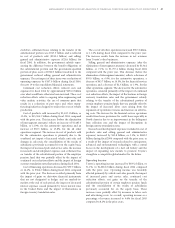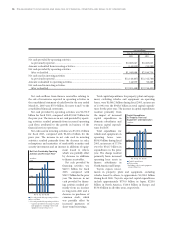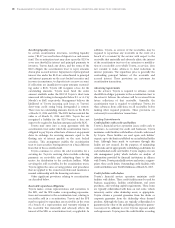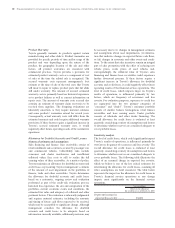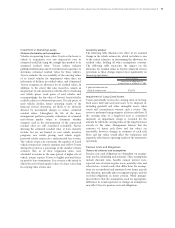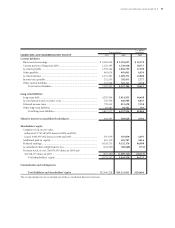Toyota 2005 Annual Report Download - page 72
Download and view the complete annual report
Please find page 72 of the 2005 Toyota annual report below. You can navigate through the pages in the report by either clicking on the pages listed below, or by using the keyword search tool below to find specific information within the annual report.
70 >MANAGEMENT’S DISCUSSION AND ANALYSIS OF FINANCIAL CONDITION AND RESULTS OF OPERATIONS
RELATED PARTY TRANSACTIONS
Toyota does not have any significant related party transac-
tions other than transactions with affiliated companies in
the ordinary course of business as described in note 12 to
the consolidated financial statements.
LEGISLATION REGARDING END-OF-LIFE
VEHICLES
In September 2000, the European Union approved a direc-
tive that requires member states to promulgate regulations
implement the following by April 21, 2002:
•manufacturers shall bear all or a significant part of the
costs for taking back end-of-life vehicles put on the market
after July 1, 2002 and dismantling and recycling those
vehicles. Beginning January 1, 2007, this requirement
will also be applicable to vehicles put on the market
before July 1, 2002;
•manufacturers may not use certain hazardous materials
in vehicles sold after July 2003;
•vehicles type-approved and put on the market from
three years after the amendment of the directive on
type-approval shall be re-usable and/or recyclable to a
minimum of 85% by weight per vehicle and shall be re-
usable and/or recoverable to a minimum of 95% by
weight per vehicle; and
•end-of-life vehicles must meet actual re-use of 80% and
re-use as material or energy of 85%, respectively, of
vehicle weight by 2006, rising respectively to 85% and
95% by 2015.
See note 23 to the consolidated financial statements for
further discussion.
RECENT ACCOUNTING PRONOUNCEMENTS
IN THE UNITED STATES
In November 2004, FASB issued FAS No. 151, Inventory
Costs—an amendment of ARB No. 43, Chapter 4 (“FAS
151”). FAS 151 amends the guidance in ARB No. 43,
Chapter 4, “Inventory Pricing,” to clarify the accounting
for abnormal amounts of idle facility expense, freight,
handling costs, and wasted material (spoilage). Paragraph
5 of ARB 43, Chapter 4, previously stated that “. . . under
some circumstances, items such as idle facility expense,
excessive spoilage, double freight, and rehandling costs
may be so abnormal as to require treatment as current
period charges. . . .”. FAS 151 requires that those items be
recognized as current-period charges regardless of
whether they meet the criterion of “so abnormal.” In
addition, this Statement requires that allocation of fixed
production overheads to the costs of conversion be based
on the normal capacity of the production facilities. FAS
151 is effective for inventory costs incurred during fiscal
years beginning after June 15, 2005. Management does not
expect this statement to have a material impact on
Toyota’s consolidated financial statements.
In December 2004, the Financial Accounting Standards
Board (“FASB”) issued FAS No. 123(R), Share-Based
Payment (revised 2004) (“FAS 123(R)”). FAS 123(R) is a
revision of FASB Statement No. 123, Accounting for
Stock-Based Compensation (“FAS 123”), supersedes APB
Opinion No. 25, Accounting for Stock Issued to
Employees (“APB 25”), and its related implementation
guidance. FAS 123(R) requires a public entity to measure
the cost of employee services received in exchange for an
award of equity instruments based on the grant-date fair
value of the award. That cost will be recognized over the
period during which an employee is required to provide
service in exchange for the award. FAS 123(R) also
requires a public entity to initially measure the cost of
employee services received in exchange for an award of
liability instruments based on its current fair value; the fair
value of that award will be remeasured subsequently at
each reporting date through the settlement date. Changes
in fair value will be recognized as compensation cost over
that period. Although Toyota is required to implement the
standard as of the beginning of the first interim or annual
period that begins after June 15, 2005 under Statement
No. 123(R), the Securities and Exchange Commission has
amended the compliance date and Toyota is required to



